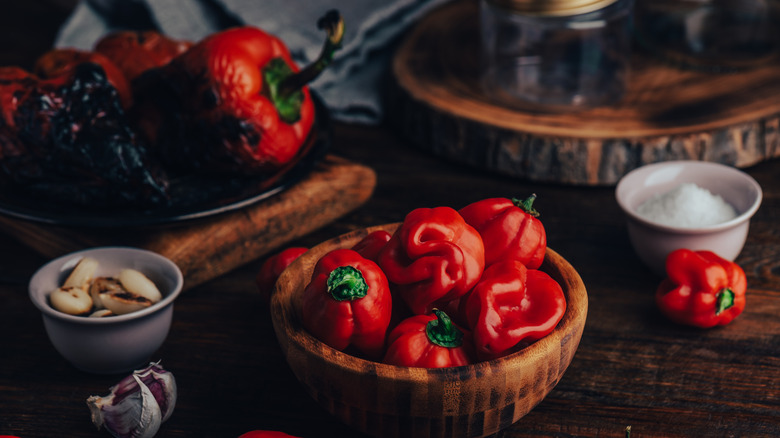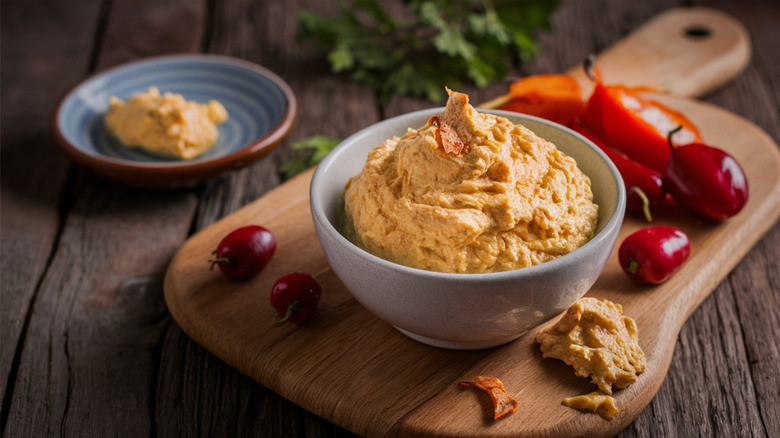Are Pimentos The Same As Roasted Red Peppers?
Ever found yourself puzzled at the grocery store, staring at jars of roasted red peppers and pimentos, wondering if they're the same thing? Great question! While both peppers add a burst of flavor and color to our plates, they're not quite equal. Pimentos are a variety of peppers known for their sweet, mild taste and small, round red pods. Roasted red peppers, on the other hand, are often made from a different variety, the bell pepper, and undergo a roasting process that intensifies their natural flavor.
Regardless of how you prefer using pimentos and/or roasted red peppers in your cooking, they offer similar benefits. Both are rich in nutrition and flavor, each playing its own unique role in our meals. They can be eaten as is or can be pickled or cooked, making them great for things like red pepper spreads, soups, or as toppings. You can swap one for the other in many recipes, but keep in mind that their preparation affects the dish. Roasted red peppers have a grilled flavor because they're broiled, while pimentos don't have that extra char. But what are the best ways to integrate each of them into your cooking?
Roasted red peppers rock
Roasted red peppers are like the rock stars of the pepper world. Think about a pepper broiling until its skin blisters and blackens then peels away to reveal tender flesh underneath. This process adds a well-seasoned taste, with a slightly charred edge. Although roasted red peppers are rooted in the Americas, they have been celebrated in Mediterranean cuisine for centuries, often appearing in everything from vibrant salads like Mediterranean orzo to condiments like romesco sauce. Their smoky allure and versatility have made them a beloved ingredient across many cultures.
The process of roasting transcends their culinary use, embodying a remarkable transformation akin to alchemy. As they roast, they develop a symphony of sweet, smoky, and subtly spicy flavors. Their influence is profound; in Spain, roasted peppers revolutionized local cuisine, becoming integral to dishes like "pisto," a classic Spanish stew. Their vibrant essence, infused with the Mediterranean sun, is now central to Southern European fare, from Italy's robust sauces to Greece's savory dips. This integration highlights their journey from indigenous ingredient to an indispensable element in global kitchens.
The sweet story of pimentos
Beyond its use in the iconic pimento cheese, pimento peppers have a fascinating history and global presence as well. Native to Central and South America, the pimento pepper was once used as a form of money and has been cherished for centuries. When used in gazpacho, they blend seamlessly with the cool mix of tomatoes and cucumbers with just a hint of sweetness. In Italy, pimento-stuffed olives add a flavorful punch to antipasto platters, surrounded by rich meats and cheeses. And in the American South, pimentos elevate deviled eggs and casseroles, turning simple dishes into something special. It's fascinating how this unassuming pepper enriches such a diverse array of culinary traditions.
In the 1940s, pimentos were a major crop in the United States, with Woodbury, Georgia, proudly earning the title of Pimiento Capital of the World. And while you might see "pimiento" and "pimento" used interchangeably, they actually refer to different things — "pimiento" is the broader Spanish term for peppers, while "pimento" specifically denotes this small, heart-shaped variety.


